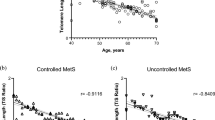Abstract
Background: Increasing evidence showed that telomere length was shorter in age-related diseases, but the mechanism of this phenomenon is still unclear. Aim: To determine whether telomere shortening occurs in Type 1 diabetes (T1D) and Type 2 diabetes (T2D), and explore the effect of antioxidant status on the telomere length. Subjects and methods: T2D patients (no.=62), T1D patients (no.=34), and non-diabetic subjects used as control (CTL) (no.=40) were included in this study. Leukocyte telomere length ratio (T/S ratio) was measured using a quantitative PCR and analyzed. Antioxidant status was estimated by human 8-hydroxy-desoxyguanosine quantization. Other biomarkers, such as fasting plasma glucose, fasting insulin, glycated hemoglobin (HbA1c) and lipid profile were also measured. Results: Compared with CTL group [T/S ratio (mean±SD), 2.39±0.55], leukocyte telomere length was significantly shorter in T2D group (1.67±0.50) and T1D group (1.77±0.50). 8-OHdG that indicated oxidative stress was significantly higher in T2D (2.99±0.85 ng/ml) and T1D (2.03±0.92 ng/ml) group than in CTL group (0.90±0.46 ng/ml). T/S ratio was significantly negatively correlated with age, waist circumference, waist-to-hip ratio, diastolic blood pressure, fasting plasma glucose, HbA1c, homeostasis model assessment of insulin resistance and 8-OHdG in the whole population. 8-OHdG was independent risk factor for telomere shortening in both T1D (p=0.018) and T2D group (p=0.022). Conclusions: In our study, shorter telomere length and increased oxidative stress were observed in both T1D and T2D. Older people with central obesity, hyperglycemia, insulin resistance and severe antioxidant status tended to have shorter telomere length. In addition, 8-OHdG was an independent predictor for telomere length for both T1D and T2D patients.
Similar content being viewed by others
References
Blackburn EH. Structure and function of telomeres. Nature 1991, 350: 569–73.
Zhao Y, Sfeir AJ, Zou Y, et al. Telomere extension occurs at most chromosome ends and is uncoupled from fill-in in human cancer cells. Cell 2009, 138: 463–75.
Salpea KD, Humphries SE. Telomere length in atherosclerosis and diabetes. Atherosclerosis 2010, 209: 35–8.
Sahin E, Depinho RA. Linking functional decline of telomeres, mitochondria and stem cells during ageing. Nature 2010, 464: 520–8.
Finkel T, Serrano M, Blasco MA. The common biology of cancer and ageing. Nature 2007, 448: 767–74.
Naudi A, Jove M, Ayala V, et al. Cellular dysfunction in diabetes as maladaptive response to mitochondrial oxidative stress. Exp Diabetes Res 2012, 2012: 696215.
Brownlee M. Biochemistry and molecular cell biology of diabetic complications. Nature 2001, 414: 813–20.
Napier CE, Veas LA, Kan CY, et al. Mild hyperoxia limits hTR levels, telomerase activity, and telomere length maintenance in hTERT-transduced bone marrow endothelial cells. Biochim Biophys Acta 2010, 1803: 1142–53.
Salpea KD, Talmud PJ, Cooper JA, et al. Association of telomere length with type 2 diabetes, oxidative stress and UCP2 gene variation. Atherosclerosis 2010, 209: 42–50.
Alberti KG, Zimmet PZ. Definition, diagnosis and classification of diabetes mellitus and its complications. Part 1: diagnosis and classification of diabetes mellitus provisional report of a WHO consultation. Diabet Med 1998, 15: 539–53.
Akhter J. The American Diabetes Association’s Clinical Practice Recommendations and the developing world. Diabetes Care 1997, 20: 1044–5.
Yang Z, Huang X, Jiang H, et al. Short telomeres and prognosis of hypertension in a chinese population. Hypertension 2009, 53: 639–45.
Mukherjee M, Brouilette S, Stevens S, Shetty KR, Samani NJ. Association of shorter telomeres with coronary artery disease in Indian subjects. Heart 2009, 95: 669–73.
Adaikalakoteswari A, Balasubramanyam M, Mohan V. Telomere shortening occurs in Asian Indian Type 2 diabetic patients. Diabet Med 2005, 22: 1151–6.
Yan J, Yang Y, Chen C, Peng J, Ding H, Wen Wang D. Short leukocyte telomere length is associated with aortic dissection. Intern Med 2011, 50: 2871–5.
Olivieri F, Lorenzi M, Antonicelli R, et al. Leukocyte telomere shortening in elderly Type2DM patients with previous myocardial infarction. Atherosclerosis 2009, 206: 588–93.
Sampson MJ, Winterbone MS, Hughes JC, Dozio N, Hughes DA. Monocyte telomere shortening and oxidative DNA damage in type 2 diabetes. Diabetes Care 2006, 29: 283–9.
Jeanclos E, Krolewski A, Skurnick J, et al. Shortened telomere length in white blood cells of patients with IDDM. Diabetes 1998, 47: 482–6.
Satoh M, Ishikawa Y, Takahashi Y, Itoh T, Minami Y, Nakamura M. Association between oxidative DNA damage and telomere shortening in circulating endothelial progenitor cells obtained from metabolic syndrome patients with coronary artery disease. Atherosclerosis 2008, 198: 347–53.
Gonenc A, Hacisevki A, Tavil Y, Cengel A, Torun M. Oxidative stress in patients with essential hypertension: A comparison of dippers and non-dippers. Eur J Intern Med 2013, 24: 139–44.
Ock CY, Kim EH, Choi DJ, Lee HJ, Hahm KB, Chung MH. 8-Hydroxydeoxyguanosine: not mere biomarker for oxidative stress, but remedy for oxidative stress-implicated gastrointestinal diseases. World J Gastroenterol 2012, 18: 302–8.
Orie NN, Zidek W, Tepel M. Increased intracellular generation of reactive oxygen species in mononuclear leukocytes from patients with diabetes mellitus type 2. Exp Clin Endocrinol Diabetes 2000, 108: 175–80.
Tentolouris N, Nzietchueng R, Cattan V, et al. White blood cells telomere length is shorter in males with type 2 diabetes and microalbuminuria. Diabetes Care 2007, 30: 2909–15.
Author information
Authors and Affiliations
Corresponding author
Rights and permissions
About this article
Cite this article
Ma, D., Zhu, W., Hu, S. et al. Association between oxidative stress and telomere length in Type 1 and Type 2 diabetic patients. J Endocrinol Invest 36, 1032–1037 (2013). https://doi.org/10.3275/9036
Accepted:
Published:
Issue Date:
DOI: https://doi.org/10.3275/9036




